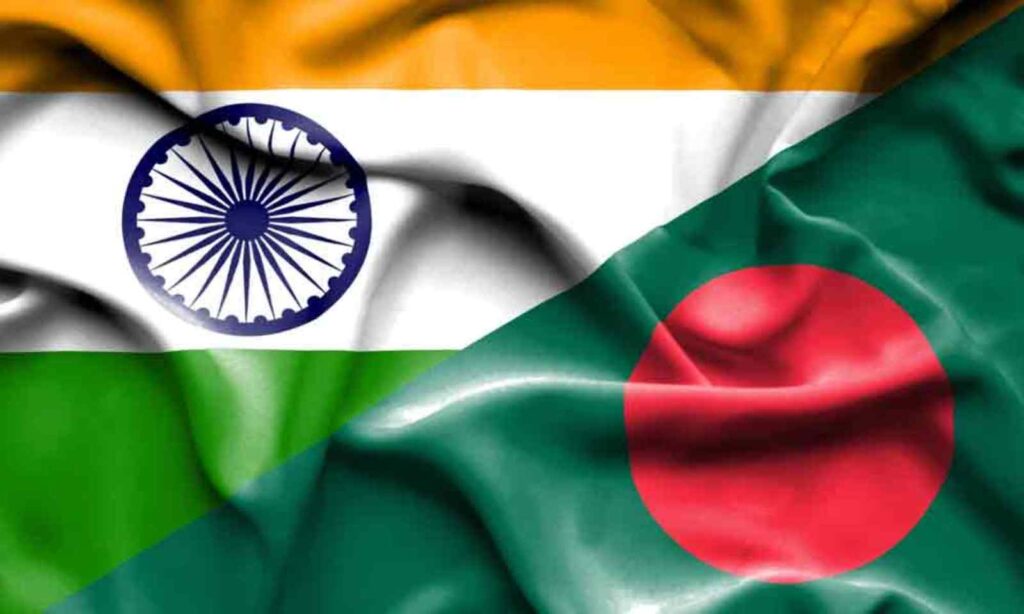DRONA BANDYOPADHYAY
SALBONI GOVERNMENT COLLEGE
‘TABA LAAGI AAMI
EI PHULBONEY
GATHEY KOTO PHULHAAR
PHUL HOYE TUMI
PHUTECHHO KI TAI
DITEY MOREY UPOHAAR’
(IN THE GARDEN OF FLOWERS I MAKE FLORAL GARLAND FOR YOU, THIS IS WHY YOU HAVE BLOSSOMED AS FLOWER TO PRESENT A GIFT TO ME).
The above couple of Bengali lines is part of a hit song, recorded by none other than Shahnaz Begum for the musical play ‘Hazar Tarer Bina’, a timeless creation of Enamul Haq and Altaf Mahmud in 1967.
More than fifty years have been passed since 1967. Our world of music, theatre, politics and all other human institutions and endeavours have gone through a colossal change as change is the only constant factor in evolutionary human existence. But these mentioned lyrical words are not only a mesmerising musical treat for me and many others but also carries a deep innermost meaning and containing a denotion of self-giving in return of realisation of a cherished goal of a beloved one.
In the broader context of bilateral relationship between India and Bangladesh, I think, the above-mentioned lyric is aptly applicable. The role of the state and people of India is intricately interwoven with the sacrifice and determination of freedom-loving people of Bangladesh in the mission of establishing an independent Bangladesh.
Popularly it is well known that 17,000 soldiers of Indian armed forces had sacrificed their lives along with the spontaneous support of the common folk of India for the oppressed people of occupied Bangladesh in 1971 who took a dangerously brave decision to launch an armed struggle to liberate their deltaic motherland from the exploitative clutches of Pakistani rule which was not only geopraphically distant but also socio-economically debilitating. The sad and sorrowful tale of long twenty-three years of Pakistani rule had purposively demoted the demographically majoritarian Bengalees into a raw material supplying and foreign-exchange earning lucrative tract of fertile lands which was the richest province in Indian subcontinent before the advent of the Britishers.
Bengal was not only a prosperous part of India in history but also carries a very intellectually vigorous tradition contributing her talent in every sector of modern educational, cultural and social exercises. Raja Rammohan Roy to Satyajit Roy, a 200 year old blazing journey of renascent accomplishments. The ingenious contribution of the Bengali Muslims in this journey is already proven and widely recognised in modern Indian subcontinent. The extraordinary personalities like Mir Mosharraf Hossain, Syed Ismail Hossain Siraji, Kazi Nazrul Islam, Begum Rokeya, Qudrat-i-Khoda, Bulbul Chowdhury and few others had generated a distinct social consciousness among the educated Bengali Muslims which was very difficult to be subjugated only in the name of Islamic faith and brotherhood because the civilizational achievements in the early centuries of Islam during the lifetimes of Prophet Muhammad and Four Khalifas was and will remain, an incessant source of inspiration for the Bengali speaking Muslims to uplift themselves to a level of social comprehension and cultivation of lofty ideals like women emancipation, freedom of the oppressed, rational thinking and other allied thoughts. These mentioned ideals are worshipped in India as her classic values of great enduring civilizational tradition since time immemorial. But in imperialist fabrication of Pakistan, minimum rearing of any progressive idea and thought was regarded as a serious threat to the artificial state. Bengal, the stormy petrel, had thrown that serious challenge to the very idea of Pakistani state just after a year of its inception in 1947. The critically logical and highly emotive issue of ‘state language’ had shown the weak foundation of the Pakistani state. The common Bengali Muslims, who had an age-old tradition of following Islam in tandem with embracing folkish culture of Bengal as true sons-of-the-soil. The humongous volumes of ‘Puthi’ literature bear a bright testimony to it. It was a historically raw fact that the Bengali Muslims overwhelmingly supported the Pakistan movement in 1940s but that did not mean they bartered their socio-economic rights for religious unity and identity. From late 1940s they had proven, time and again, the depth and strength of their association with Bengali language, script and consciousness for the rights of their land and people. The climax came in March 1971 when 1970’s electorally victorious Awami League under the astounding and electrifying leadership of Bangabandhu Sheikh Mujibur Rahman had been denied the right to form government at the centre in Pakistan. The well-entrenched military junta and some ‘shrewd’ and ’power-loving’ politicians of West Pakistan could not digest the keen and sharp verdict of an impoverished peasant community in favour of a more democratic and decentralised Pakistan though the same peasant community played an equally intense and forceful historical role to realise Pakistan in post-colonial Indian subcontinent through democratic ways and means two decades ago. The rest is history.
The modern state of India which is also the successor of the great Indian civilisation uphiolds the core values like democracy, tolerance, pluralism, non-violence, emancipation of the downtrodden, ens of the exploitation. The birth pangs of Bangladesh through a brutal liberation war had paved the path for the proud realisation of same righteous values in Bangladesh. It can be mentioned here that the ‘Proclamation of Independence’ (17th April 1971) bears the acknowledgement of the shared values cherished by India and Bangladesh. India’s glorious role of national sacrifice and humanitarian intervention to assist Bangladesh to become independent for the recognition and understanding of universal humanist values will remain an exceptional exemplication of validating some concrete values in coming ages.

